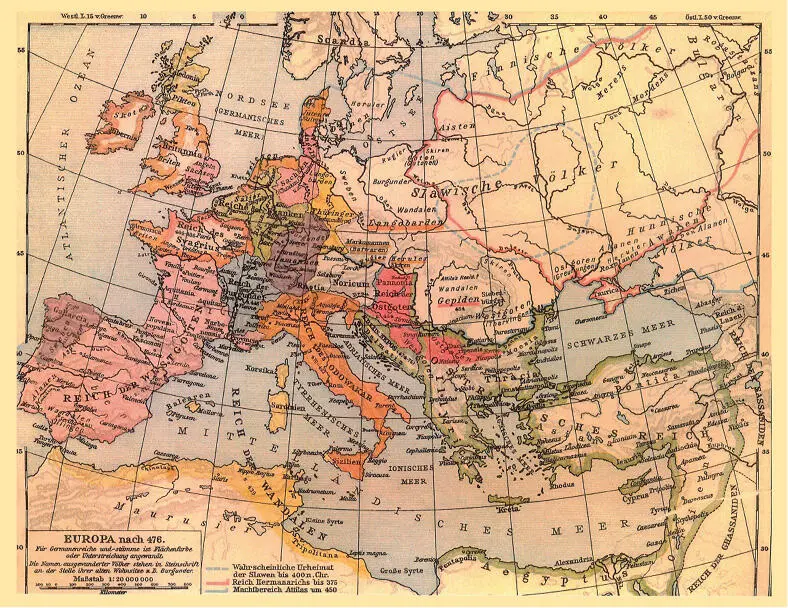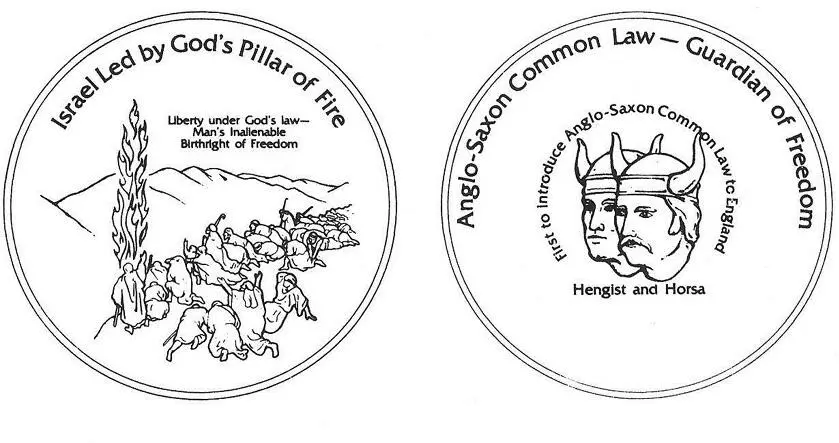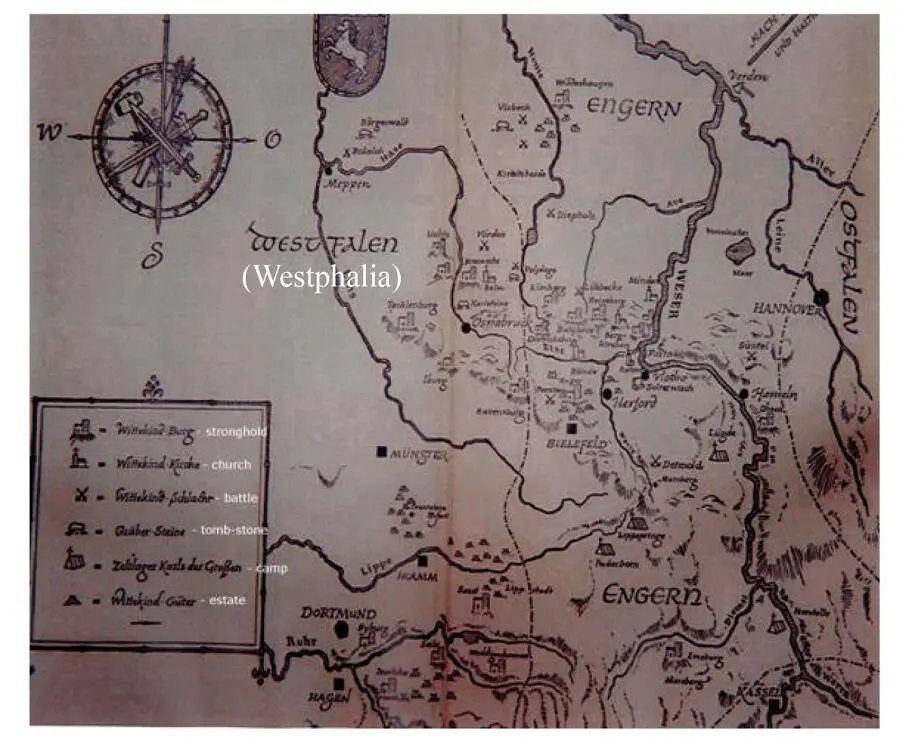(fig.:#10)

The line of Saxonian noblemen goes back to Arminius, and the most important ones thereafter came from the house of Engern. This clan with Count Bodo ruled over all the Saxons. His son Wichten, and in turn, his son Wichtigis also became dukes of the Saxons.
Around 450 A.D. Count Hengist from the same dynasty together with Prince Horsa founded a Saxonian king-dom in England and called themselves kings. At that time the English county of Herfordia got her name from a borough of Herford not far from Enger. Count Hengist is also the reason for many English lord-titles, like Elting, Lindhorst, Bathorst, Herbert and others, all going back to actual Westphalian farm places.
These same two Saxonian noblemen from Westphalia, Hengist and Horsa, should come up again 1315 years later during the preliminary discussions on the American Constitution:
A group of the Founding Fathers (Adams, Franklin, Jefferson) had a concept for the official Seal of the United States: Showing reference to the Common Law of the Anglo-Saxons on one side, represented by the Saxonian noblemen Hengist and Horsa, and on the other side, the idea of God’s Law of ancient Israel.
The original concept proposal, however, was never realized.
Several attempts have been made over time to figure out what this proposal could have looked like. One such an idea as shown in the National Center for Constitutional Studies is shown in a sketch on the following page.

After the collapse of the Roman Empire, and after Constantin III, the Roman military commander in England, withdrew his legions, England got visitors from the continent. Three Germanic tribes, the Saxons, the Jutes, and the Angles stormed part of the island. The original Celtic people didn’t have a chance. Battle after battle was lost; till only poetic revenge was left (legend of King Artus).
Around 600 AD, there were seven Anglo-Saxon kingdoms in England. One of those kingdoms was in Essex un-der the rule of King Sebert, the centre of the Saxons around London.
Most recent excavations in Essex (= East-Saxons) near Sutton-Hoo as well as in Cumwhitton near Carlisle provi-ded proof of early Germanic graves of that period. The findings in Sutton-Hoo could relate to King Sebert, who died 616 A.D., after he had converted to Christianity in 604 AD. This “royal tomb” of Sutton Hoo shows a typical set-up of the old pagan belief of the Saxons even when the corpse carried some Christians symbols.
Helmet from the Sutton Hoo ship-burial 1, England.
British Museum [CC BY-SA 2.5 (https://creativecommons.org/licenses/by-sa/2.5)]

Hengist’s son Hadugast, his successor, remained in Saxony and his son Hulderich (also known under the name of Childerich), born 584 AD, fought and protected for the first time the Saxonian territories against the power-ful, aspiring Franconians, another Germanic tribe. This conflict should prove fateful to the Saxons over the next centuries.
Around 630 AD, Hulderich’s son Sieghart (also known as Sigismund) reigned over the Saxons.
His son Dietrich, in skirmishes with the Franconians, now led by Karl Martell, was captivated and imprisoned.
Karl Martell (688 – 741AD), nicknamed the “Hammer”, son of Pipin II, was mayor of the Franconian palace. He managed to bring earlier domains of the Franconian kingdom under his control and fought the aggressive Mos-lems at Tour, pushing eastward towards various Germanic tribes.
Under him, the two principal elements of feudalism, the fief and vassalage developed, and the historic alli-ance between the Frankonian Kingdom and the Papacy began.
While Dietrich was in captivity, his wife, a duchess from the Wendish country, had two sons:
King Edelgard and Duke Warnekin. Edelgard died 753 A.D. in a battle with Pipin the Short, who is the father of Charles the Great (Charlemagne).
After this battle, Pipin the Short was the first to march into the heartland of the Saxons, all the way to the fortified castle of Rehme, located direct on the Weser River.
The Long Struggle between the Saxons and the Franks
(The land of our ancestors)
Warnekin, after succeeding his brother as king of the Saxons, had two children (sons) with his wife Kunhilde, a princess from the island of Ruegen: -- Wittekind (also known as Wedekind) and Bruno.
In 758 AD Wittekind became Duke of Engern, Westphalia, and Saxony.
He spent his childhood between Warnekin`s court at the mountain stronghold “Babilonie” in the Wiehengebirge between Herford and Osnabrück and the ancestral castle in Wigaldishausen (=Wildeshausen) on the Hunte River.
His dukedom, the free land of the Saxons, extended from the Lower-Rhine-Valley eastward to the Weser River and all the way to the Wendish (Slavic) territory in the East. (fig.:#11)
While Wittekind lived according to the old customs of his ancestors, King Karl, at the same time, tried to spread Christianity. Later in history, King Karl was named “Charlemagne”.
And while the Saxons had built a number of fortified places (Soest, Iserlohn, Hohensyburg, Seiler, Arnsberg, Eresburg, etc.) against the pressing Franks, King Karl, at the same time, gathered his “Royal-Court” in Worms and proclaimed war against the Saxons.
The Franconian records report a statement from King Karl: “First the castles and then the hearts”.
Saxon versus Franks around 800 AD
Some details of the 30 year long struggle are shown in the graph below: (fig.:#11)
A “stronghold” is a fortified place at the time = bulwark on hills surrounded by stockades and walls of soil and woodwork. (fig.:#11)

Why these details?
Because the conflict between Wittekind and King Charles (Charlemagne), resulted finally in the bloody subjuga-tion of the Saxons and was another major turning point in the history of our area.
The map of fig.:#11 shows a number of fortified places which the Saxons used in their struggle against their neighbours in later years, especially against the Franconians, another Germanic tribe.
The thrust of the Franconian army was pushing alongside the Weser River towards the heart of the Engern people, one of the four tribes of the Saxons. This expedition left a trail of devastation behind: Farms and grain fields went up in flame. There was robbing, and looting, etc.
As always in the long history of mankind: the farmers took most the brunt of the harm.
The story of this conflict is mostly based upon two sources: the Franconian narrative (some in writing), and the abundant information included in the Saxon version, passed on through generations and kept alive in numerous legends.
Wittekind and Geva, a daughter of Godefried, the king of Denmark, had three daughters: Ida, Ravena, and Tekla. He built a fortified castle for each of them: Iburg for Ida, Ravensburg for Ravena and Tecklenburg for Tekla.
Those three castles protected the chain-mountains of the Teutoburger Wald against aggressors.
Iburg, as the saying goes, was the strongest foothold against the Franks. From here, Wittekind directed a series of assaults; and yet he could not hold the ground for long. As Iburg was lost, he moved to Ravensburg; and this stronghold was soon taken by the Franks as well. This made him move to Tecklenburg. Finally, King Karl overran Tecklenburg also, and he dismantled all three of them thoroughly.
Читать дальше
















